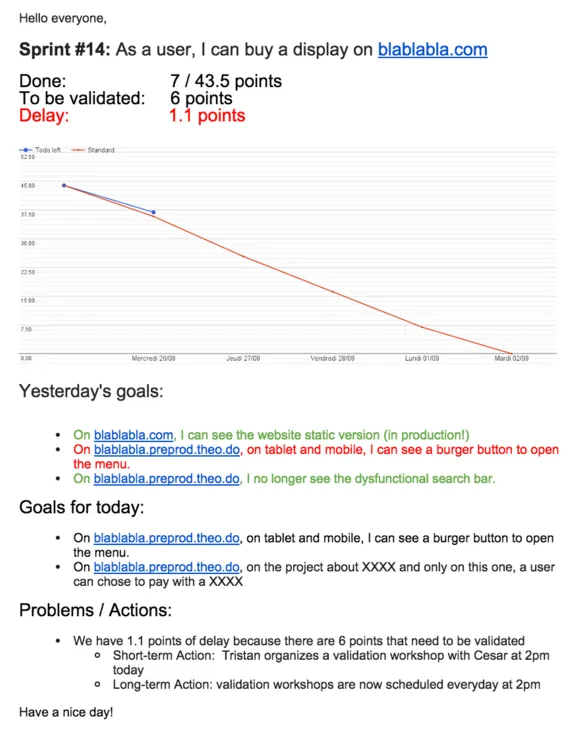You want to do Scrum? Start with Daily Reports
Nicolas Girault5 min read

Who is your client?
In every professional relation, you have a provider and a client. Whether she’s your boss or the head of a company you’re dealing with, the client is the one you are creating value for and she is the one you want to bring onboard.
At Theodo we help our clients to solve their business problems with code. It is crucial to us that the people at the company we work with - who often don’t get anything about coding - understand our progress towards the goal we determined together. Which means we need to make visible to them the value we add.
Ideally, we’d work side-by-side with our clients. They’d see us working and we’d show them our deliverable right when we are done. Unfortunately, although they are the ones with the business vision, they’re never full time on our project and tend to be busy with other subjects. As for technical teams, the complexity of our topic makes it even harder to keep them onboard.
So we asked ourselves how to provide transparency to our clients and came out with a powerful tool.
First, what do we need?
We agreed on 4 criteria:
- easy to get and targeted: decision-makers are busy people. They want straight-to-the-point info. No noise. With the most important information made blatant.
- understandable for outsiders: your clients have providers themselves and they need to report to someone as well. They need jargon-free reports they can transmit to their clients.
- daily-basis: to maintain contact and allow to be reactive in case of problem.
- easy and fast to produce: transparency is essential for the success of a project but is not an end in itself. The time to write this report should not spill over your work. The maximum timebox for this exercise should be 15 minutes. Done is better than perfect.
Second, what do we do?
Let us introduce you to The Theodo Daily Mail™.
It’s a simple and short document with key characteristics:
- The short-term objective set for your team (i.e. number of sales completed during a month, number of recruitments achieved, features developed, etc.)
- One key metric updated on a daily-basis (and presented in a visual manner)
- A check on the goals your team committed to the day before
- A forecast of the goals you want to reach today
- A list of the problems you’re facing and the actions you plan on taking to solve them

In addition, here are 2 pieces of advice we’d like to share: keep your style sober and be precise.
Colors need to be meaningful: use colors as signals, and keep them seldom. At Theodo, for instance, we agreed that we only needed green and red to highlight whether we reached our goals for the day before or not. Same for fonts, sizes and decoration: if you’re going to use them, make sure they help understand your message better, otherwise they add nothing but noise.
Most importantly, be accurate in your report. Precision is key: use actual facts (how many sales appointments did you get?, how many applicants did you meet?, what functionality exists today that didn’t yesterday?). And please, write sentences with action verbs, active forms and check dates. Especially when it comes to problem-solving. Instead of writing “the last functionalities need to be validated”, prefer “Steve, can you validate that the signup form we developed works? We’ll make a check at 3pm today”.
After months of experimentations, here’s what we’ve learned.
So, third,what’s the outcome?
Our Daily Mail was meant to solve the transparency issue (“how do I show the value I create for my client”) and here are two examples of feedbacks we got.
I had no idea of what you (the IT team) were doing, now it’s super clear. I know exactly what to expect today. Thanks.
Yahya Tahri, Product Strategy Manager BNP Paribas Investment Partners
I forwarded it to the head of IT of my main investor to show them our progress.
The CEO of a cool start-up we worked for
We realized that not only we managed to give more information to our interlocutors and create trust but we also gave them a tool to communicate with their own clients. Digging deeper, we realized that there were other unexpected advantages to our Daily Mail. Here is what we found:
- Writing a Daily Mail makes you ask yourself consistent questions everyday. It brings discipline to yourself and the team. It forces you to formulate problems you encounter and track the effect of the actions you take. In other words it helps you begin a continuous improvement process.
- With Daily Mails, teams share indicators to communicate their progress towards measurable goals. But the report itself is an indicator of the team’s motivation: motivated teams write efficient and meaningful Daily Mails. If the reports you get don’t match the 4 criteria we listed above, you should see that as a problem and take actions to react.
- When you set daily goals, you commit yourself to them. It reinforces your engagement to make the team and the project succeed.
Let’s keep going
At Theodo we are strong Scrum advocates. As praised by the very official Scrum Guide, we believe that Transparency, Inspection and Adaptation are key pillars to help teams improve continuously and eventually succeed in their projects. We found that writing Daily Mails was instrumental in implementing such a process within development teams.
The Theodo Daily Mail™ is one version of this virtuous report we tried to define. It’s still a work in progress and we’d be happy to have your feedback to improve it.